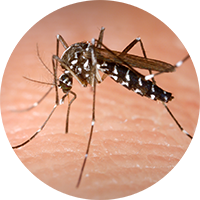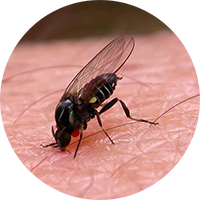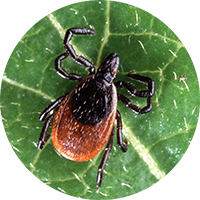Tick Frequently Asked Questions
1What tick species transmit disease?
The deer tick is the primary tick that transmits disease in Minnesota. Deer tick habitat is woods and brush. The wood tick (also known as the American dog tick) is primarily a pest, although it does transmit disease in other US states. Wood tick habitat is tall grass. The other MN tick species generally don’t use humans as a host.
2What is Lyme disease?
Lyme disease is an illness caused by bacteria that are transmitted by infected deer ticks. It was named Lyme disease after doctors in the village of Lyme, CT noticed a cluster of peculiar juvenile arthritis cases in 1975 and were credited as being the first to identify it. (In reality, dermatologist RJ Scrimenti of Milwaukee, WI accurately diagnosed and described it in 1970.)
3What other diseases can deer ticks spread?
Although Lyme disease is more common, deer ticks can also spread human granulocytic anaplasmosis and babesiosis. Each of these diseases usually involves a very high fever and typically has no rash. Other symptoms include chills, headache, and muscle aches. See your doctor if you suspect you have become infected. Deer ticks can simultaniously transmit more than one disease.
4What are the symptoms of Lyme disease?
A rash, sometimes called a “bulls eye” rash, can appear 3-30 days after a person is infected. The rash doesn’t appear in every case. Headache, fever, chills, fatigue, and muscle and joint pain can also be symptoms of early Lyme disease infection. If left untreated, early symptoms usually disappear. Later, more serious symptoms like arthritis, brain impairment, irregular heart beat, and persistent fatigue can appear.
5If a deer tick bites me, will I catch Lyme disease?
Not necessarily. Quickly finding and removing the deer tick is a key to preventing Lyme disease. Ticks must remain attached for at least 24 hours before they can infect you, and not all deer ticks carry the bacteria.
6Is Lyme disease treatable?
Yes. Early treatment with antibiotiocs is effective in preventing damage from Lyme disease. Later stage Lyme disease can also be treated, but early detection and treatment is simpler. See your doctor if you suspect you have become infected.
7Can MMCD do anything about ticks?
There is currently no wide-scale economical and environmentally sound way to control ticks. There are repellants for humans and your veterinarian or farm supply store can recommend repellants for animals. Repellants, wearing light-colored clothing, and avoiding their habitat are the best way for people to avoid ticks. MMCD monitors deer ticks in the metro area, advises homeowners on landscaping and small scale tick control techniques, helps educate the public about Lyme disease, and offers free tick identification, but we don’t control deer ticks.
8What about other tick species in Minnesota?
Other tick species found in low numbers in Minnesota can carry other tick-borne diseases. For example, the Lone Star tick has been reported from time to time and can spread a tick-borne disease called human monocytic ehrlichiosis (HME). HME is rare in Minnesota but more common in the southern United States.



